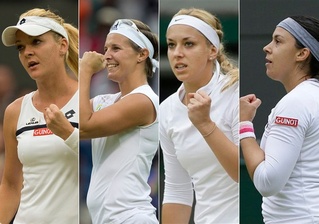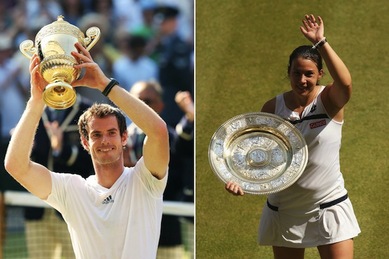This Women's Wimbledon Final will not have names like Williams, Sharpova or Azarenka but it promises to have some great competitive tennis played by women with desire - to win that is!

WIMBLEDON, England--“Radwanska! Bartoli!!!!! It’s the Wimbledon Women’s Final
on NBC!”
This was the mocking message that ESPN commentator Bill Simmons sent to the world via Twitter on Tuesday, after Sloane Stephens became the last American in the women’s draw at Wimbledon to be sent home. Whatever you think of his faux-drumroll, Simmons did make one undeniable mistake. As @NBC Sports tweeted back to him: “The final is on ESPN.”
Yes, Simmons’ own network will have the privilege of broadcasting the
upcoming matches between the four women’s semifinalists. Or, as Bill himself
might put it: Radwanska! Lisicki! Bartoli! and, last but not least, the
Belle from Belgium, the Woman Behind the Shades, L’il Kimmy
herself—Flipkens!!!
Simmons’ reaction is the standard one in the United States. Once all of our
stars are knocked out of a Grand Slam, we suddenly become very concerned about
the ratings of the TV networks that carry the tournament. It’s hardly necessary,
of course; ESPN, love it or hate it, is locked into tennis for the long haul,
and most recent major finals have delivered the marquee names it craves. Still,
I get it: It's not wrong for fans to want their sport to be watched by the
widest audience possible. The thought of American commentators like Mike Tirico
or Ted Robinson working hard to sell a Saturday morning, Breakfast at Wimbledon,
match-up between 20th-ranked Kirsten Flipkens and 24th-ranked Sabine Lisicki to
a Stateside audience is admittedly a little painful.
In part, though, that’s only because we’ve been trained by TV to think of
Grand Slam finals as heavyweight fights, world events, occasions of momentous
importance, clashes of the titans. The match, in this formulation, is only as
significant as the stars who grace it with their presence. Things are even worse
in the U.S., where sports fans’ eyes begin to glaze a little when any
foreign-sounding name is mentioned. Our reaction to the rest of the world often
comes down to a one word question: “Who?”
But this Wimbledon should remind us that, even in tennis's Age of Dominance,
the majors don’t belong to any set, elite group of players. The game’s
hierarchies aren’t carved in stone, and a Slam, unlike a season in a team sport,
represents just two weeks of play. It shouldn’t be surprising that every so
often the results go a little haywire. Even during the vaunted golden era of the
1970s and 80s, chaos lurked. As the Independent reports this morning,
in 1983, of the 16 players seeded to reach the Wimbledon quarterfinals
in both draws, only four of them made it that far. This is the way it works on a
regular basis in golf. You never know who you’re going to see coming down back
nine on Sunday at a major, but even casual fans will stay with it. The drama
of watching anyone try to win a trophy that prestigious is enough for most of us.
In this sense, the 2013 women’s event offers a different, but no less
intriguing and rewarding, reason to tune in for the last two rounds. We won’t
see Serena Williams or Maria Sharapova or Victoria Azarenka add to their
already-established résumés as major champions and Hall of Fame players.
Instead, we’ll have a chance to watch something more emotional and pure: Four
women who have never won a Grand Slam, and who may have doubted they would ever
win one, trying to make that dream come true. “Make that dream come true” is a
corny phrase, but the sentiment will be appropriate for the champion on
Saturday. As good as all four of these players are, none of them was
destined to win Wimbledon.
And each has a story and playing style that’s as compelling as Serena’s or
Sharapova’s.
We’ll watch as Lisicki tries, for the second time in a Wimbledon semifinal,
to tame her lethal but unruly power game. The German made it this far two years
ago, but over the last week there’s been a new glint of confidence in her eye,
and a "cat who ate the canary" curl to her press-conference smile. On court, few
players express joy with the abandon of Lisicki. Her victory celebration would
be one to remember.
Her semifinal opponent, the undersized, squat-shotting Agnieszka Radwanska,
has defied the odds for years by using a finesse game to climb the rankings in a
ball-belter’s world. A Wimbledon win by her would be the final proof that touch,
craft, and inventiveness still have a very big place in the allegedly “brutal”
modern version of the sport.
Marion Bartoli is tennis’s eye-bulging eccentric, as famous for her
between-point calisthenics as she is for her huge two-handed cuts at the ball.
There would be an ironic and poignant side to a Bartoli win. On the one hand,
she would have triumphed using the strange and widely-dismissed techniques
taught to her by her father, Walter. On the other, she would have done it
without him in her corner for one of the few times in her 28 years. The two
haven’t been working together during the fortnight.
Finally, there’s Flipkens, the least familiar of the four. It may be hard to
see past her sunglasses, but the 27-year-old Belgian brings old-fashioned
variety with her one-handed backhand. And she may have the best story of all. A
former world No. 1 junior, she was tapped to carry on in the tradition of
countrywomen Kim Clijsters and Justine Henin. It didn’t quite work out that way,
and last year she developed blood clots in her calf that sidelined her for two
months. She lost funding from the Belgian tennis federation, and her ranking
slipped to No. 262 a year ago. As a stunned Flipkens said yesterday, she
couldn’t even get into the qualifying draw at Wimbledon in 2012, and now she’s
in the semifinals. Clijsters’ support in particular helped make her comeback
possible. As Kim tweeted yesterday, she had tears in her eyes at the end of
Flipkens’ upset quarterfinal win over Petra Kvitova.
Lisicki and Radwanska are 1-1 against each other; Flipkens and Bartoli have
never played. I'll take Lisicki and Bartoli to win, each in three sets.
None of these four may ever have this chance again. If you like
unpredictability and desperate desire in your tennis, you have to like that. And
if you’ve ever dreamed of playing in the final and winning Wimbledon, you’ll
have a chance to see what it feels like to have that seemingly impossible dream
fulfilled. Forget stars, this is sports.


 RSS Feed
RSS Feed